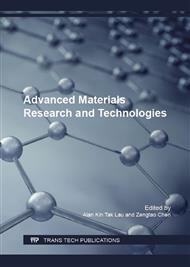[1]
P. Alexandridis, T.A. Hatton, Poly (ethylene oxide) poly (propylene oxide)poly (ethylene oxide) block copolymer surfactants in aqueous solutions and at interfaces: thermodynamics, structure, dynamics, and modeling, Colloid Surface A, 96 (1995).
DOI: 10.1016/0927-7757(94)03028-x
Google Scholar
[2]
X.Y. Xiong, K.C. Tam, L.H. Gan, Polymeric Nanostructures for Drug Delivery Applications Based on Pluronic Copolymer Systems, J Nanosci Nanotechnol, 6 (2006) 2638-2650.
DOI: 10.1166/jnn.2006.449
Google Scholar
[3]
L. Klouda, A.G. Mikos, Thermoresponsive hydrogels in biomedical applications, Eur J Pharm Biopharm, 68 (2008) 34-45.
Google Scholar
[4]
B. Jeong, S.W. Kim, Y.H. Bae, Thermosensitive sol–gel reversible hydrogels, Adv Drug Deliver Rev, 54 (2002) 37-51.
DOI: 10.1016/s0169-409x(01)00242-3
Google Scholar
[5]
D.A. Chiappetta, A. Sosnik, Poly(ethylene oxide)–poly(propylene oxide) block copolymer micelles as drug delivery agents: Improved hydrosolubility, stability and bioavailability of drugs, Eur J Pharm Biopharm, 66 (2007) 303-317.
DOI: 10.1016/j.ejpb.2007.03.022
Google Scholar
[6]
S.D. Desai, J. Blanchard, In vitro evaluation of pluronic F127‐based controlled‐release ocular delivery systems for pilocarpine, J Pharm Sci, 87 (1998) 226-230.
DOI: 10.1021/js970090e
Google Scholar
[7]
G. Bonacucina, M. Cespi, G. Mencarelli, G. Giorgioni, G.F. Palmieri, Thermosensitive Self-Assembling Block Copolymers as Drug Delivery Systems, Polymers, 3 (2011) 779-811.
DOI: 10.3390/polym3020779
Google Scholar
[8]
C.C. Chen, C.L. Fang, S.A. Al-Suwayeh, Y.L. Leu, J.Y. Fang, Transdermal delivery of selegiline from alginate-Pluronic composite thermogels, Int J Pharm, 415 (2011) 119-128.
DOI: 10.1016/j.ijpharm.2011.05.060
Google Scholar
[9]
K. Moebus, J. Siepmann, R. Bodmeier, Alginate-poloxamer microparticles for controlled drug delivery to mucosal tissue, Eur J Pharm Biopharm, 72 (2009) 42-53.
DOI: 10.1016/j.ejpb.2008.12.004
Google Scholar
[10]
V. Nair, Poloxamer gel as vehicle for transdermal iontophoretic delivery of arginine vasopressin: evaluation of in vivo performance in rats, Pharmacol Res, 47 (2003) 555-562.
DOI: 10.1016/s1043-6618(03)00043-4
Google Scholar
[11]
E.A. Yapar, Ö. Ýnal, Poly (ethylene oxide)–poly (propylene oxide)-based copolymers for transdermal drug delivery: An overview, Trop J Pharm Res, 11 (2013) 855-866.
DOI: 10.4314/tjpr.v11i5.20
Google Scholar
[12]
W. Wang, E. Wat, P.C.L. Hui, B. Chan, F.S.F. Ng, C.W. Kan, X. Wang, H. Hu, E.C.W. Wong, C.B.S. Lau, P.C. Leung, Dual-functional transdermal drug delivery system with controllable drug loading based on thermosensitive poloxamer hydrogel for atopic dermatitis treatment, Sci Rep, 6 (2016).
DOI: 10.1038/srep24112
Google Scholar
[13]
Oecd, OECD Guidelines for the Testing of Chemicals, Organization for Economic, (1994).
Google Scholar
[14]
B.C. Chan, L.F. Li, S.Q. Hu, E. Wat, E.C. Wong, V.X. Zhang, C.B. Lau, C.K. Wong, K.L. Hon, P.C. Hui, P.C. Leung, Gallic Acid Is the Major Active Component of Cortex Moutan in Inhibiting Immune Maturation of Human Monocyte-Derived Dendritic Cells, Molecules, 20 (2015).
DOI: 10.3390/molecules200916388
Google Scholar
[15]
K.Y. Liu, S. Hu, B.C. Chan, E.C. Wat, C.B. Lau, K.L. Hon, K.P. Fung, P.C. Leung, P.C. Hui, C.W. Lam, C.K. Wong, Anti-inflammatory and anti-allergic activities of Pentaherb formula, Moutan Cortex (Danpi) and gallic acid, Molecules, 18 (2013).
DOI: 10.3390/molecules18032483
Google Scholar
[16]
S.L. Borgia, P. Schlupp, W. Mehnert, M. Schäfer-Korting, In vitro skin absorption and drug release–a comparison of six commercial prednicarbate preparations for topical use, Eur J Pharm Biopharm, 68 (2008) 380-389.
DOI: 10.1016/j.ejpb.2007.05.003
Google Scholar
[17]
L. Shargel, S. Wu-Pong, A.B. Yu, Physiologic Drug Distribution and Protein Binding in: Applied biopharmaceutics & pharmacokinetics, McGraw-Hill, 2012, p.211.
Google Scholar
[18]
Y. Li, J. Rodrigues, H. Tomas, Injectable and biodegradable hydrogels: gelation, biodegradation and biomedical applications, Chem Soc Rev, 41 (2012) 2193-2221.
DOI: 10.1039/c1cs15203c
Google Scholar
[19]
M.R. Prausnitz, R. Langer, Transdermal drug delivery, Nat Biotechnol, 26 (2008) 1261-1268.
DOI: 10.1038/nbt.1504
Google Scholar


